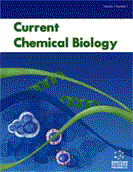Abstract
Copper has potent biocidal properties. Copper ions, either alone or in copper complexes, have been used for centuries to disinfect liquids, solids and human tissue. This manuscript reviews the biocidal mechanisms of copper and the current usages of copper and copper compounds as antibacterial, antifungal and antiviral agents, with emphasis on novel health related applications. These applications include the reduction of transmission of health-associated (nosocomial) pathogens, foodborne diseases, and dust mites loads and treatment of fungal foot infections and wounds. Possible future applications include filtration devices capable of deactivating viruses in solutions, such as contaminated blood products and breastmilk.
Keywords: Copper, biocide, fungicide, antiviral, acaricidal, nosocomial infections, wound healing
Current Chemical Biology
Title: Copper, An Ancient Remedy Returning to Fight Microbial, Fungal and Viral Infections
Volume: 3 Issue: 3
Author(s): Gadi Borkow and Jeffrey Gabbay
Affiliation:
Keywords: Copper, biocide, fungicide, antiviral, acaricidal, nosocomial infections, wound healing
Abstract: Copper has potent biocidal properties. Copper ions, either alone or in copper complexes, have been used for centuries to disinfect liquids, solids and human tissue. This manuscript reviews the biocidal mechanisms of copper and the current usages of copper and copper compounds as antibacterial, antifungal and antiviral agents, with emphasis on novel health related applications. These applications include the reduction of transmission of health-associated (nosocomial) pathogens, foodborne diseases, and dust mites loads and treatment of fungal foot infections and wounds. Possible future applications include filtration devices capable of deactivating viruses in solutions, such as contaminated blood products and breastmilk.
Export Options
About this article
Cite this article as:
Borkow Gadi and Gabbay Jeffrey, Copper, An Ancient Remedy Returning to Fight Microbial, Fungal and Viral Infections, Current Chemical Biology 2009; 3 (3) . https://dx.doi.org/10.2174/2212796810903030272
| DOI https://dx.doi.org/10.2174/2212796810903030272 |
Print ISSN 2212-7968 |
| Publisher Name Bentham Science Publisher |
Online ISSN 1872-3136 |
 10
10
- Author Guidelines
- Bentham Author Support Services (BASS)
- Graphical Abstracts
- Fabricating and Stating False Information
- Research Misconduct
- Post Publication Discussions and Corrections
- Publishing Ethics and Rectitude
- Increase Visibility of Your Article
- Archiving Policies
- Peer Review Workflow
- Order Your Article Before Print
- Promote Your Article
- Manuscript Transfer Facility
- Editorial Policies
- Allegations from Whistleblowers
- Announcements
Related Articles
-
COVID-19, the Brain, and the Future: Is Infection by the Novel Coronavirus
a Harbinger of Neurodegeneration?
CNS & Neurological Disorders - Drug Targets Small Ruminant Lentiviruses and Human Immunodeficiency Virus: Cousins that Take a Long View
Current HIV Research Targeted Hydrolysis of Beta-Amyloid with Engineered Antibody Fragments
Current Alzheimer Research Strategies to Diminish the Ab Load in Alzheimers Disease
Current Medicinal Chemistry - Central Nervous System Agents Searching for Disease-Modifying Drugs in AD: Can We Combine Neuropsychological Tools with Biological Markers?
CNS & Neurological Disorders - Drug Targets The Role of Neurogenesis in Neurodegenerative Diseases and its Implications for Therapeutic Development
CNS & Neurological Disorders - Drug Targets Astrocytes and Inflammasome: A Possible Crosstalk in Neurological Diseases
Current Medicinal Chemistry DNA Microarrays - An Armory for Combating Infectious Diseases in the New Century
Infectious Disorders - Drug Targets Treatment of Viral Encephalitis
Central Nervous System Agents in Medicinal Chemistry The Effects of Soluble Aβ Oligomers on Neurodegeneration in Alzheimer's Disease
Current Pharmaceutical Design Neurocysticercosis: The Enigmatic Disease
Central Nervous System Agents in Medicinal Chemistry Ginkgo Biloba Extract (EGb 761) in Alzheimers Disease: Is there Any Evidence?
Current Alzheimer Research Active Amyloid-β Vaccination Results in Epigenetic Changes in the Hippocampus of an Alzheimer’s Disease-Like Mouse Model
Current Alzheimer Research Long-Term Extensions of Randomized Vaccination Trials of ACC-001 and QS-21 in Mild to Moderate Alzheimer’s Disease
Current Alzheimer Research Effects of Medicinal Plants on Human Hosts and Zoonotic Helminthic Infections: A Systematic Review
The Natural Products Journal The Intracellular Domain of Amyloid Precursor Protein is a Potential Therapeutic Target in Alzheimer’s Disease
Current Drug Discovery Technologies Disrupting β-Amyloid Aggregation for Alzheimer Disease Treatment
Current Topics in Medicinal Chemistry Targeting Protozoan Parasite Metabolism: Glycolytic Enzymes in the Therapeutic Crosshairs
Current Medicinal Chemistry Immunotherapy for Alzheimers Disease: Potential Problems and Possible Solutions
Current Immunology Reviews (Discontinued) Novel Synthetic Compounds as Potential Anticryptococcal Agents
Current Organic Synthesis

















.jpeg)








